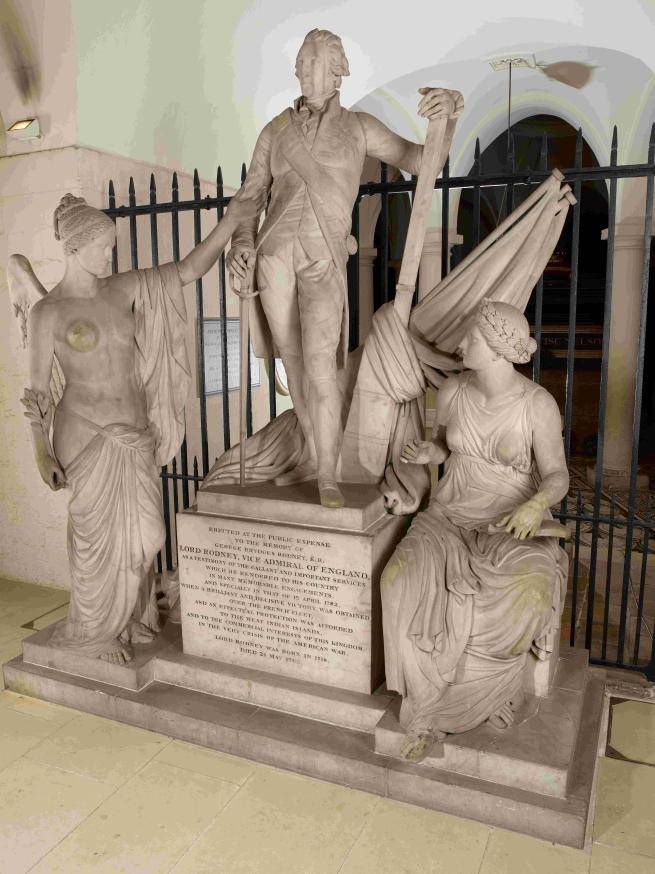George Bridges Rodney

Image courtesy of Pantheons – Sculpture at St Paul's Cathedral (c.1796–1916) (york.ac.uk)
George Bridges Rodney
1st Baron Rodney (1718-92)
Part of War and resistance in the Caribbean: The monuments at St Paul's: A digital trail produced in collaboration with SV2G.
The following entry has been researched and written in collaboration with members of SV2G.
Note: We are only at the start of the journey toward centring the Caribbean voice in the Revolutionary Wars. The campaigns have traditionally been documented without a focus on the impact on local populations. Although the archival records offer limited information and this area of historical study is under-developed, our project raises awareness about the activities of the British campaigns in the Caribbean and their lasting legacies, and introduces visitors to a number of Caribbean heroes.

Lord George Rodney was born into a slave-investing family: his father had investments in the South Sea Company, which had a monopoly on trade with the Spanish colonies of South America, including trade in enslaved peoples from Africa. The catastrophic financial crash of 1720 known as the ‘South Sea Bubble’ led to his father’s ruin, which contributed to Rodney’s lifelong struggle with gambling and debt.
In 1762 George Rodney led the British forces who mounted an attack on Martinique, the success of which made him hugely popular. Rodney’s fame was further cemented when, as described in this monument, a ‘decisive victory was obtained over the French fleet, and an effectual protection was afforded to the West Indian Islands, and to the commercial interests of this kingdom’. The event referred to is the Battle of the Saintes, fought during the American Revolutionary War. The French, viewing the American war as an opportunity to recuperate its losses following the Seven Years’ War, joined the American patriot cause in 1778. Their support helped the Americans defeat the British, and in 1781, Lieutenant General Charles Cornwallis, commanding the British army, notoriously surrendered at the Siege of Yorktown. Signalling the loss of the American colonies, this surrender caused significant damage to Cornwallis’ reputation among the British public: his large monument at St Paul’s, making sole reference to his governorship of Bengal, ignores his humiliation in America. French armies now focused attention on their real ambition: supremacy over the Caribbean islands. Having already earlier reclaimed Dominica, Saint Vincent and the Grenadines, Grenada, Tobago, Saint Kitts, and Nevis from the British, the French navy allied with the Spanish to conquer Barbados and Jamaica. Rodney was sent to fight the French fleet in the group of islets called Les Saintes, and his victory at the famous three-day Battle of the Saintes in April 1782 proved a counterbalance to the loss of the British colonies in America. One member of Parliament declared it ‘perhaps the greatest victory ever recorded in the naval annals of this country’, because this one victory had completely compensated for the losses in America.
A year before this battle, Rodney had also captured the Dutch-owned Caribbean island of Sint Eustatius, an island populated by enslaved Africans and their descendants. Rodney engaged in actions which proved particularly controversial. He designated the inhabitants of the island as prisoners of war, whose goods and property must be seized. He also gave 350 Sephardic and Ashkenazim inhabitants 24 hours to leave the island and stripped them of clothes and personal possessions before they left. The British only maintained control of Sint Eustatius for 10 months, and during the journey to Britain, much of the loot Rodney had taken from the island was captured by a French squadron.

Listen to an audio-recording of this text read by a member of SV2G. Sound recording by Marlon Lewis, Life in Frames.
For detailed information about this monument, visit the Pantheons: Sculpture at St Paul's Cathedral website.

War and resistance in the Caribbean
The monuments at St Paul's
Explore the full digital trail produced in collaboration with SV2G.




